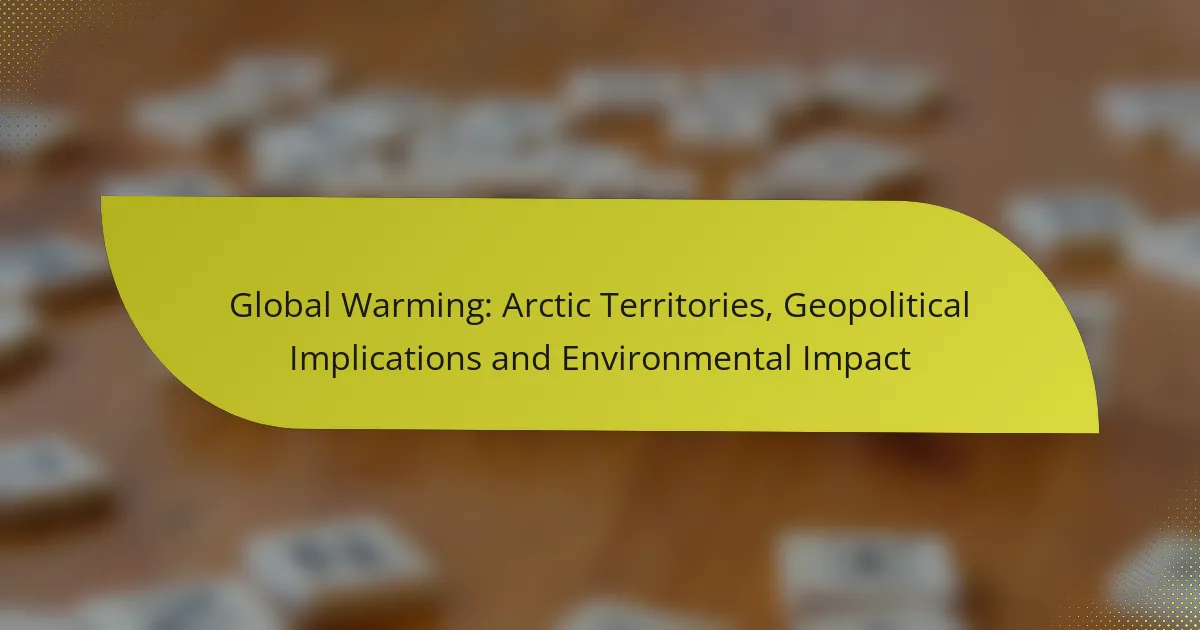Global warming is profoundly transforming Arctic territories, leading to accelerated ice melting and significant ecological shifts. These environmental changes not only threaten local wildlife and indigenous communities but also have far-reaching geopolitical implications, as new shipping routes and resource opportunities intensify competition among nations. The resulting tensions and territorial disputes are reshaping international relations in this strategically vital region.

How does global warming affect Arctic territories?
Global warming significantly impacts Arctic territories by accelerating the melting of ice and altering ecosystems. These changes have profound implications for the environment, wildlife, and the indigenous populations that rely on these regions for their livelihoods.
Melting ice caps
Melting ice caps in the Arctic are a direct consequence of rising global temperatures. As temperatures increase, the polar ice melts at an accelerated rate, leading to thinner ice and reduced sea ice extent during summer months.
This loss of ice not only contributes to rising sea levels but also affects global weather patterns. The reduction in ice cover can lead to increased absorption of solar energy by the ocean, further exacerbating warming trends.
Rising sea levels
Rising sea levels are a critical issue stemming from the melting ice caps in the Arctic. As glaciers and ice sheets melt, they contribute to the overall volume of the world’s oceans, which can lead to coastal flooding and erosion.
For coastal communities, even a rise of a few centimeters can have significant impacts, increasing the risk of storm surges and saltwater intrusion into freshwater supplies. This poses a threat to infrastructure, ecosystems, and human settlements in low-lying areas.
Impact on wildlife
The impact of global warming on wildlife in the Arctic is profound, as many species depend on ice-covered habitats for survival. For instance, polar bears rely on sea ice for hunting seals, their primary food source.
As ice diminishes, these animals face challenges in finding food and breeding grounds, leading to population declines. Additionally, changing temperatures can disrupt migration patterns and breeding cycles for various species, resulting in ecological imbalances.
Changes in indigenous lifestyles
Indigenous communities in the Arctic are experiencing significant changes in their lifestyles due to global warming. Traditional hunting and fishing practices are becoming more difficult as ice conditions change, impacting food security and cultural practices.
As wildlife migrates or becomes less accessible, these communities must adapt to new realities, often facing economic challenges. The loss of traditional knowledge and practices can further threaten their cultural identity and resilience.
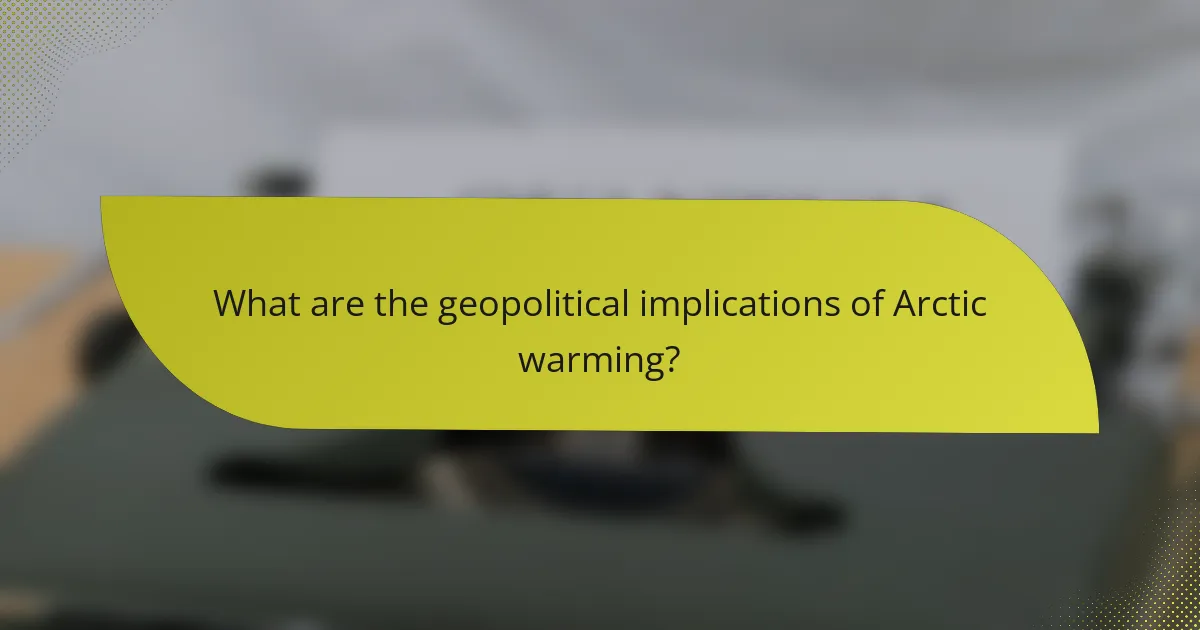
What are the geopolitical implications of Arctic warming?
The geopolitical implications of Arctic warming are significant, as melting ice opens new shipping routes and exposes untapped natural resources, leading to increased competition among nations. This situation heightens tensions and territorial disputes, reshaping international relations in the region.
Increased territorial disputes
As Arctic ice diminishes, countries are vying for control over newly accessible areas, leading to heightened territorial disputes. Nations like Russia, Canada, and the United States are asserting claims over parts of the Arctic, often based on interpretations of international law, such as the United Nations Convention on the Law of the Sea (UNCLOS).
These disputes can escalate into diplomatic conflicts, as countries may engage in military posturing or seek to strengthen their presence in contested regions. For example, the Northwest Passage is a focal point of contention, with Canada asserting sovereignty while other nations view it as international waters.
Access to natural resources
The Arctic is rich in natural resources, including oil, gas, and minerals, which are becoming more accessible due to warming temperatures. Estimates suggest that the Arctic may hold a significant percentage of the world’s undiscovered oil and gas reserves, prompting nations to explore these opportunities.
Countries are investing in technology and infrastructure to extract these resources, which can lead to economic benefits but also environmental risks. The race for resources can create friction between nations, especially when environmental regulations are perceived as barriers to development.
Strategic military positioning
With the Arctic becoming more navigable, military strategies are evolving as nations seek to secure their interests. Countries are increasing their military presence in the region, conducting exercises, and establishing bases to assert their claims and protect their assets.
This militarization raises concerns about potential conflicts and the need for cooperative frameworks to manage the region. Nations must balance their strategic interests with the necessity of maintaining peace and addressing environmental challenges that arise from increased military activity.
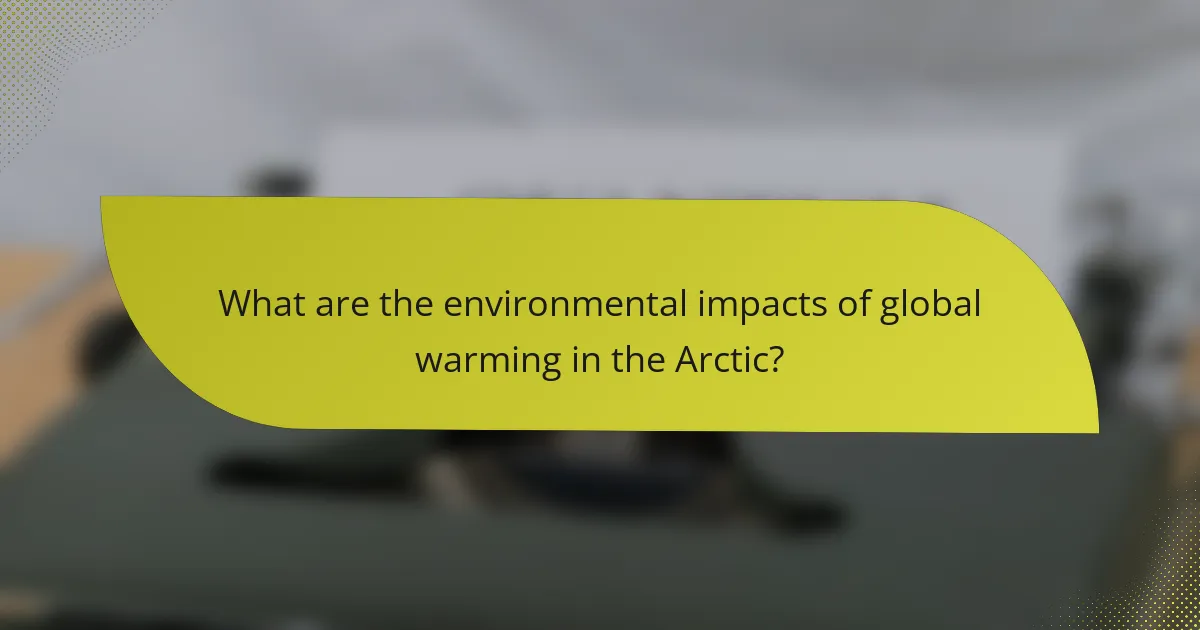
What are the environmental impacts of global warming in the Arctic?
Global warming significantly affects the Arctic environment, leading to severe consequences such as habitat loss, altered weather patterns, and increased greenhouse gas emissions. These changes threaten not only local wildlife but also global climate stability.
Loss of biodiversity
The warming climate in the Arctic results in habitat destruction, which directly impacts the region’s biodiversity. Species such as polar bears, seals, and various migratory birds face challenges as their habitats shrink and food sources diminish.
As ice melts, the delicate balance of Arctic ecosystems is disrupted, leading to a decline in species that rely on ice-covered regions for breeding and hunting. This loss of biodiversity can have cascading effects throughout the food web, affecting both terrestrial and marine life.
Altered ecosystems
Global warming is transforming Arctic ecosystems, shifting the distribution of plant and animal species. Warmer temperatures allow for the encroachment of non-native species, which can outcompete local flora and fauna, further destabilizing these ecosystems.
Additionally, changes in precipitation patterns and increased thawing of permafrost alter soil composition and nutrient availability, impacting vegetation growth. These shifts can lead to a loss of traditional habitats for indigenous species and disrupt the livelihoods of local communities that depend on these ecosystems.
Increased greenhouse gas emissions
As the Arctic warms, permafrost thaw releases significant amounts of stored greenhouse gases, particularly methane and carbon dioxide. This release contributes to global warming, creating a feedback loop that exacerbates climate change.
Estimates suggest that the Arctic region could release billions of tons of carbon as permafrost continues to thaw. This not only accelerates climate change but also poses risks to global weather patterns and sea-level rise, affecting populations far beyond the Arctic region.
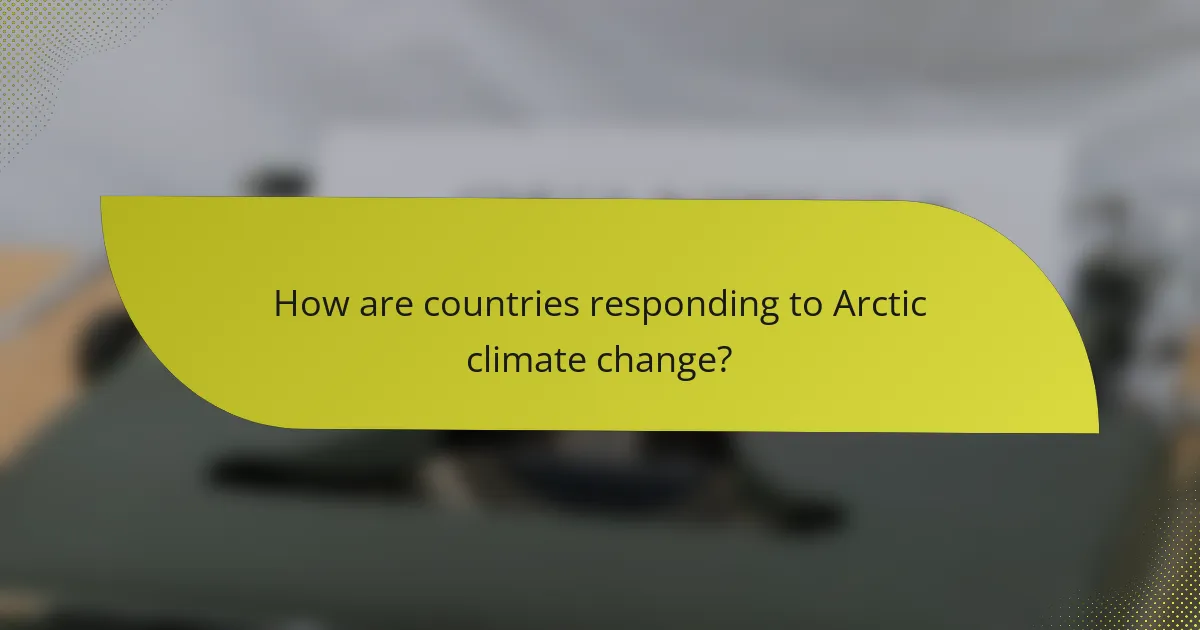
How are countries responding to Arctic climate change?
Countries are responding to Arctic climate change through a combination of international treaties, national policies, and research initiatives aimed at mitigating environmental impacts and addressing geopolitical challenges. These responses involve collaborative efforts and regulatory frameworks designed to protect the fragile Arctic ecosystem while balancing economic interests.
International treaties and agreements
International treaties play a crucial role in coordinating responses to Arctic climate change. Agreements such as the Paris Agreement and the Arctic Council’s framework encourage nations to commit to reducing greenhouse gas emissions and promoting sustainable development in the region. These treaties facilitate cooperation on scientific research, environmental protection, and resource management.
Additionally, the United Nations Convention on the Law of the Sea (UNCLOS) provides guidelines for maritime boundaries and resource exploitation, ensuring that Arctic nations can navigate the complexities of territorial claims while addressing climate-related challenges.
National policies and regulations
Countries with Arctic territories, such as Canada, Russia, and Norway, have implemented national policies to address climate change impacts. These policies often include regulations aimed at reducing emissions, protecting biodiversity, and promoting renewable energy sources. For example, Canada has set ambitious targets to reduce greenhouse gas emissions by 40-45% below 2005 levels by 2030.
Furthermore, nations are developing adaptation strategies to manage the effects of climate change on local communities and ecosystems. This includes investing in infrastructure improvements and enhancing disaster preparedness to cope with increased flooding and erosion.
Research and monitoring initiatives
Research and monitoring initiatives are essential for understanding the effects of climate change in the Arctic. Countries are investing in scientific studies that focus on climate patterns, wildlife behavior, and ecosystem health. Collaborative research projects, often funded by government and academic institutions, aim to gather data that informs policy decisions and conservation efforts.
Monitoring programs, such as satellite observations and on-the-ground assessments, help track changes in ice cover, sea levels, and temperature fluctuations. This data is vital for developing effective responses to the ongoing environmental changes and ensuring the sustainability of Arctic resources.
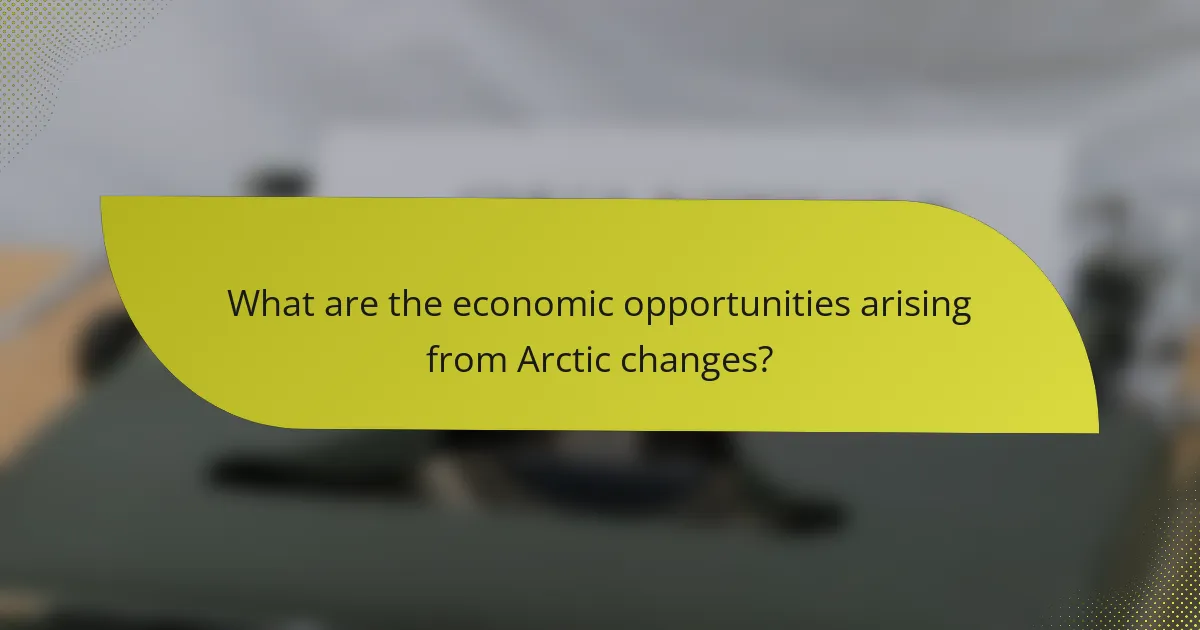
What are the economic opportunities arising from Arctic changes?
The changing Arctic environment presents various economic opportunities, primarily driven by the melting ice and shifting ecosystems. Key areas of growth include expanded shipping routes, increased oil and gas exploration, and a rise in tourism, each with unique implications and considerations.
Shipping route expansion
The reduction of sea ice in the Arctic is opening new shipping routes, significantly shortening travel times between major markets. For instance, the Northern Sea Route can reduce shipping distances from Europe to Asia by up to 40% compared to traditional routes through the Suez Canal.
However, companies must consider environmental regulations and the potential for increased shipping traffic to impact local ecosystems. Investing in ice-class vessels and adhering to international maritime guidelines will be crucial for safe and sustainable operations.
Oil and gas exploration
The Arctic holds substantial reserves of oil and natural gas, making it an attractive area for energy companies. Estimates suggest that the region may contain around 13% of the world’s undiscovered oil and 30% of its undiscovered natural gas.
Exploration activities are subject to stringent regulations due to environmental concerns, particularly regarding oil spills and their impact on fragile ecosystems. Companies must navigate complex legal frameworks and engage with local communities to ensure responsible development.
Tourism growth
As the Arctic becomes more accessible, tourism is expected to grow significantly. Travelers are increasingly interested in experiencing the unique landscapes and wildlife of the region, with activities ranging from cruises to adventure tourism.
Stakeholders in the tourism sector should focus on sustainable practices to minimize environmental impacts. Collaborating with indigenous communities can enhance the visitor experience while ensuring that local cultures and ecosystems are respected and preserved.
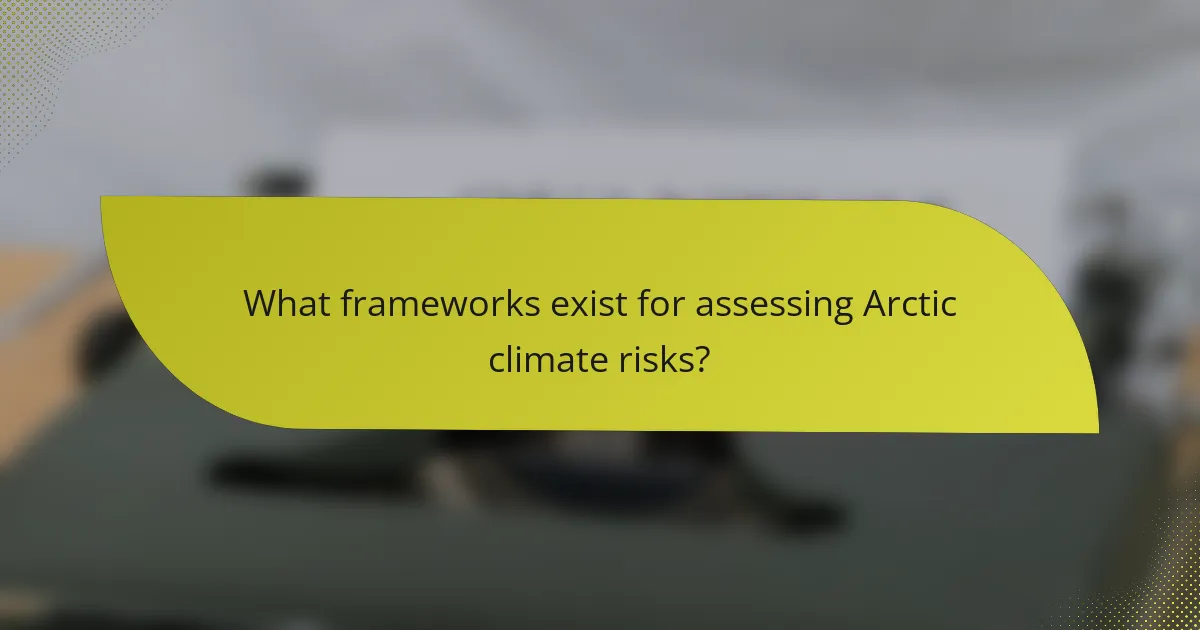
What frameworks exist for assessing Arctic climate risks?
Frameworks for assessing Arctic climate risks include climate impact assessments and geopolitical risk analysis. These frameworks help stakeholders understand environmental changes and their broader implications for international relations and local communities.
Climate impact assessments
Climate impact assessments evaluate the potential effects of climate change on the Arctic environment, including changes in temperature, ice melt, and biodiversity loss. These assessments typically involve modeling future climate scenarios and analyzing their impacts on ecosystems and human activities.
Key factors to consider in these assessments include the rate of ice loss, shifts in wildlife populations, and the potential for increased natural resource extraction. For instance, the melting of permafrost can release greenhouse gases, further exacerbating climate change.
Geopolitical risk analysis
Geopolitical risk analysis focuses on the implications of climate change for international relations, particularly in the Arctic region. This analysis examines how environmental changes can influence territorial claims, resource competition, and security dynamics among Arctic nations.
Stakeholders should consider factors such as changing shipping routes due to melting ice, increased military presence in the region, and the potential for conflicts over resources like oil and gas. Understanding these geopolitical risks is crucial for policymakers and businesses operating in or near the Arctic.
